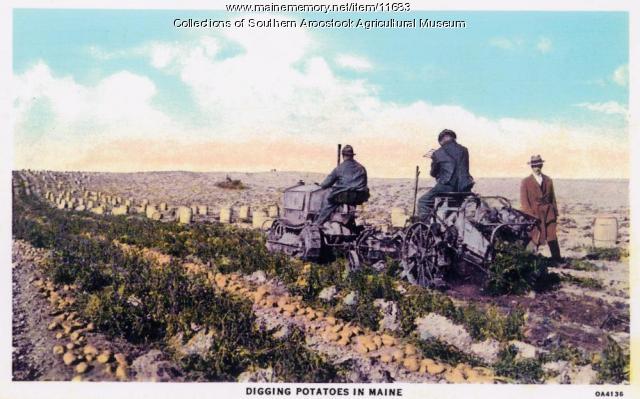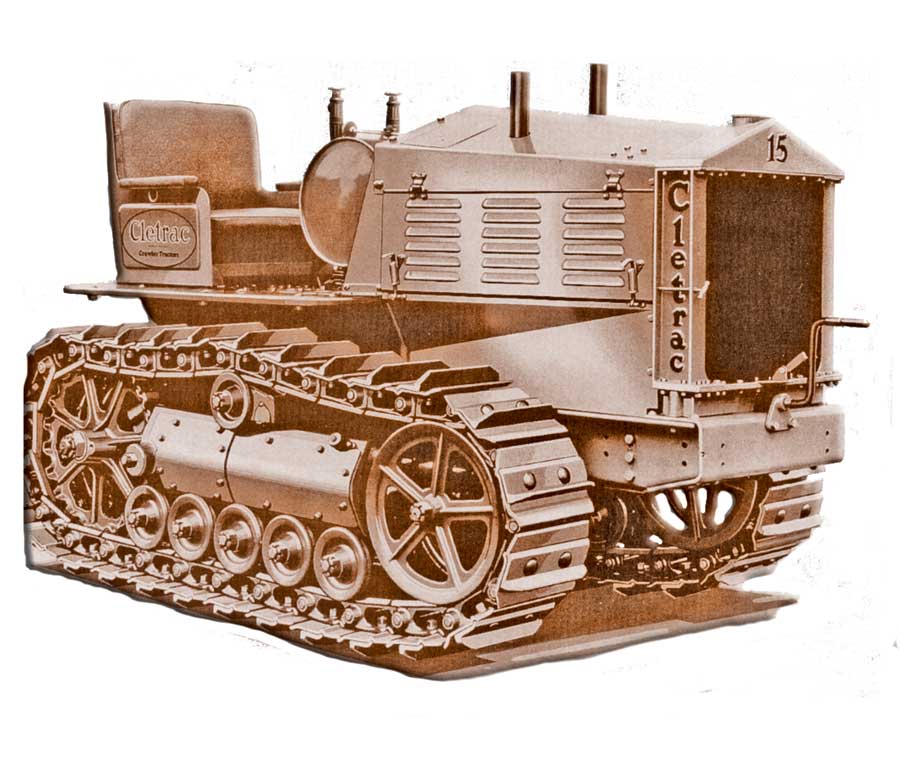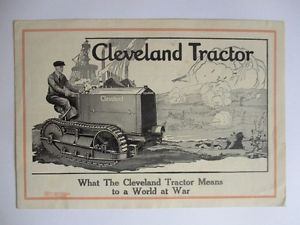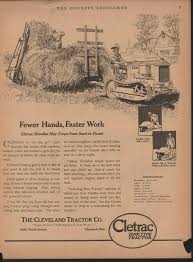Cletrac
AKA: Cleveland Motor Plow Co. / Cleveland Tractor Co., Cleveland, Ohio, USA
History

Cletrac Model W with potato digger in Maine
Rollin H. White was born in Cleveland, Ohio in 1872 and on graduation from Cornell University he joined his father's business, the White Sewing Machine Co. By the turn of the century he had invented a flash-type boiler and installed it in the first White steam car. He subsequently set a new world speed record for a steam-powered carriage and in 1906 he formed the White Motor Car Co., which would later grow into the world-famous White Motors Corporation. In 1911, Rollin and his brother Clarence G. White began to turn their attention to farm tractors, and the following year they filed a patent for a three-wheeled design of motor plough. This led to the formation of the Cleveland Motor Plow Co. at Cleveland, Ohio on 20th January 1916, with a factory constructed on a 38-acre site at nearby Euclid, but by the time the motor plough patent was granted in March 1918 they had already shifted their focus to crawler-type tractors.
The inspiration for the "Cleveland" crawler of 1916 came from an experimental version of the C.L. Best Gas Traction Company's 8-16 hp "Pony" tracklayer, which had been purchased by Rollin H. White at the 1915 Pan-Pacific Exhibition in California the previous year. The "Cleveland", however, incorporated White's invention of controlled differential steering, which allowed the power of the engine to be transmitted to both tracks at all times and gave rise to the slogan "Geared to the Ground". The following year the company changed its name to the Cleveland Tractor Co. and in 1918 the little crawler became known as the "Cletrac". (After the First World War, advertisements for the Cletrac often referred to it as the "Tank-Type Tractor", no doubt attempting to capitalise on the success of tanks during the conflict.) It went on to receive a number of modifications over the next few years, and the successive models were subsequently christened the R, H and W, corresponding to Rollin H. White's initials. The 1920s saw Cleveland respond to the demand for more powerful crawlers, with the introduction of several more models of increasingly higher horsepower, culminating in the massive 100hp Cletrac 100. The various models were mostly powered by petrol engines bought in from companies such as Buda, Hercules and Wisconsin, although Cletrac did build some of their own power units. In 1933, following Caterpillar's example, diesel engines were introduced as an option in Cletrac crawlers, and the whole range received a cosmetic overhaul in 1937 with the introduction of a streamlined bonnet and radiator grille. In 1944 the Cleveland Tractor Co. was purchased by the Oliver Corporation, who continued to offer Cletrac crawlers under their own name, until they in turn were bought out by the White Motors Corporation in 1960.
Cletrac crawlers were exported worldwide and proved especially popular in Europe. In England the Model R, H and W were imported by H.G. Burford of North Kensington, London, with early examples being advertised as the "Burford-Cleveland". A copy of the Cletrac Model H known as the LIMO was built in Sweden in the 1920s by the Lindholmen-Motala firm, but it is unclear whether this was licensed; the tractor looks identical to the Cletrac except for the use of a T-bar (as on the Holt) in place of a steering wheel. Cletrac 20K tractors were also built under license in France from the late 1920s by the Allied Machinery Co. of Paris, and saw a great deal of use in the country's vineyards. The Soviet Union was a major customer for Cletrac crawlers and in the late 1920s they entered into negotiations with the Cleveland Tractor Co. to build their tractors under license, but it seems this was never realised. Finally, there is evidence that the Japanese KATO company also experimented with a crawler design based around a Cletrac, but whether this went into production is uncertain.
Model Details
Cleveland Motor Plow

Cleveland Motor Plow
The patent diagrams for the Cleveland Motor Plow show a tricycle design with two wide roller-like rear wheels and a pair of closely-spaced front wheels. According to the description the engine "may be of any desired type", and this transmitted its power to the rear wheels via a two-speed gearbox and chain and sprocket drive. The key feature of the machine consisted of two sets of rotating discs, mounted transversely below the chassis just behind the rear wheel and powered by a long drive shaft from the engine. These gangs of discs could be raised and lowered via a rack and pinion, and also swept back in order to change the angle at which they engaged the soil: If they were oriented perpendicular to the chassis they acted as a disc harrow, whereas if they were set at an angle, they acted as a disc plough. It seems that the Cleveland company experimented with several versions of their motor plough, as a surviving photo shows a substantially different machine. The frame with the discs has now been moved to the rear is raised and lowered via a winch and cable rather than a rack and pinion. The rear wheels are substantially narrower, and may have even been combined into a single drive drum. It is not clear how many Cleveland Motor Plows were built or whether it even went beyond the prototype stage.
Model R
The first Cleveland Tractor (which would later be referred to as the Model R) was a 12-20 hp machine. It seems that early examples may have used a Waukesha engine, but this was soon replaced by Buda Model R power unit with 3.5" bore and 5.125" stroke. Two forward speeds and one reverse were provided and it was advertised as being powerful enough to pull a 14" two-furrow plough and turn over 8-10 acres per day. The engine compartment was fully enclosed and had the same angular profile as the sheet-metal radiator surround. The track frames were of fairly light construction, made from angle iron and flat bar, and looped around the narrow tracks at the front to allow attachment of springs that were fixed to the front of the chassis. As mentioned previously, steering was via the controlled differential method in which a turn of the steering wheel in one direction causes the corresponding track to be slowed down via a brake and planetary gear arrangement, while the other speeds up due to the action of the differential; this allows turns to be accomplished without loss of power to either track. Production of this model began in 1916 and ended the following year, during which time a total of 1000 were reportedly built. Serial numbers ran from 1 to 1000. (Later Oliver documentation mentions that the engine number was the same as the serial no., but this was certainly not the case with the Buda engines, which were numbered separately.)
Model H

Advertisement for the Model R from 1917
Advertisement for the Model R from 1917
(click on image to enlarge)
The Cleveland Tractor received some modifications in 1918, the most significant of which were the substitution of the Buda engine with a Weidely M power unit and the strengthening of the track frames - this new version was to become known as the Model H. The Weidely engine was a 3.75 x 5.5" unit but the tractor was still given a 12-20 hp rating. The first Model H tractors were externally almost identical to the Model R, with narrow tracks and sheet-metal radiator, the main difference being the heavier track frames; later examples received wider tracks and a cast radiator (after serial no. 6181) with the "Cleveland" name painted on the top tank. The Model H was built from 1917 to 1919 and carried serial numbers 1001 to 13755, while engine numbers were in the range 30001 to 43068.
Model W
The Model W (later known as the Cletrac "12") was the final version of the 12-20 hp crawler, and incorporated a number of changes to the Model H design: the top track roller was dispensed with, the radiator now had the "Cletrac" name cast into it, the two-piece track frame guard was replaced with a single piece, a water bath air-cleaner was added as standard and the colour of the tractor changed from green to dark grey. Early examples of the Model W used a similar Weidely engine to the Model H (with a slightly larger bore of 4"), but this was substituted for an almost identical Cletrac-built unit midway through production. The Model W was the first crawler tractor to be tested at Nebraska, in July/August 1920 - the test report mentions that it was fitted with a Kingston Model L carburettor and Teagle Model 66-S magneto. The Model W was produced between 1919 and 1932 with serial numbers 13756 to 30971; the Weidely engine numbers ranged from 43069 to 52123, while the Cletrac ones ran from 101 to 19873.
Model F
The Cletrac Model F, which appeared in 1920, incorporated an innovative new track system using a specially designed roller chain, which removed the need for track rollers and a front idler wheel. Each track frame was provided with a channel running along its entire length in which the roller chain could move freely. On the outside of the roller chain was the track itself, which had a similar channel for the roller chain to run in. The design was such that the entire track assembly could operate without lubrication. Another novel feature was that the drive sprocket was raised up well above the ground away from mud and dirt, thus anticipating modern crawler designs. The main body of the tractor was of unit construction, with the engine, transmission and differential assemblies forming a single entity, thus providing greater rigidity and compactness and allowing a single lubrication point. The engine in the Model F was Cletrac's own four-cylinder 3.25 x 4.5 in unit running at 1600 rpm - the 9-16 hp rating for the tractor proved rather conservative when it was tested at Nebraska in April 1922, yielding over 13 hp at the drawbar and nearly 20 hp on the belt. The report mentions that a Tillotson CD1A carburettor and Eisemann GS4 magneto were fitted. One limitation of the tractor was the fact that it only had a single forward and reverse gear, although the gear shift via a pinion and two bevel gears allow the usual transmission gear train to be eliminated. The track width and ground clearance of the Model F could be easily adjusted to several different configurations to allow it to work in a wide variety of crops, and special two-row and straddle-row front-mounted cultivators were also available. The Model F was built from 1920 until 1922 - serial numbers and engine numbers were identical and ran from 1 to 3000.
Model 20K

Cletrac F in France with
rear-mounted vineyard plough,
raised and lowered via
a pulley-driven winch
Cletrac F in France with rear-mounted vineyard plough, raised and lowered via a pulley-driven winch (click on image to enlarge)
The Model K (later known as the Cletrac "20") was introduced in 1925 with a 15-25 hp rating, but after an impressive showing at Nebraska the following year it was uprated to 20-27 hp. The engine was built in house, and was a 4 x 5.5 in unit with a rated speed of 1375 rpm. This was coupled with a Tillotson R2 carburettor and Eisemann GS4 magneto, and a Pomona oil-fibre air-cleaner kept it free from dust. The overall appearance of the Model K was similar to that of the Model W, although the track frames were shorter due to a different suspension design. Production lasted from 1925 until 1932, with serial numbers in the range 101 to 10207 and engine numbers in the range 6520 to 19884.
Model 30A
The Model A, rated at 30-45 hp, was the first Cletrac to use a six-cylinder engine. This was a Wisconsin Model H overhead-valve design with 4 in bore and 5 in stroke (1575 rpm), and featured a Tillotson ST3A carburettor and Eisemann GS6 magneto according to the 1926 Nebraska test report. The Model A was produced from 1926 until 1929, with serial numbers 6 to 1421 and engine numbers 1212 to 3584, before being replaced by the Model B with a similar 6cyl Wisconsin GT engine.




